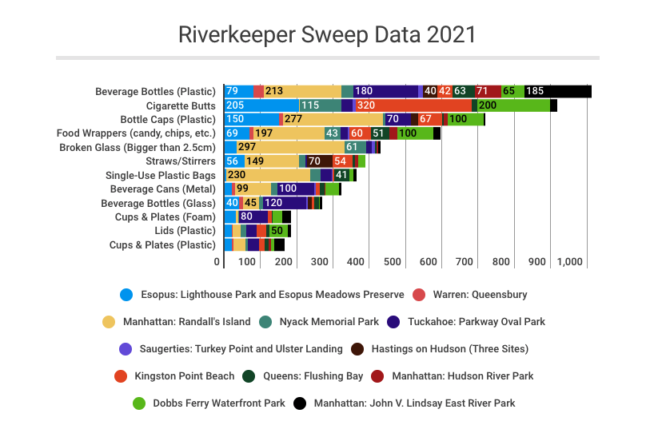What’s in our river? Sweep volunteers examine Hudson River plastic pollution

View more images on our Flickr site
Volunteers sorted and counted shoreline trash at a dozen locations during Riverkeeper Sweep. Here’s what they found on May 1, 2021.
Every shoreline cleanup proves it: Plastic waste remains an enormous problem for our waterways and the life within them. Carried into the water through storm drains and other routes, plastic trash breaks down into microplastic particles and fibers, which find their way into marine wildlife, our drinking water, food sources, and our own bodies. Riverkeeper is assisting research on the prevalence of microplastic and the contaminants that adhere to these plastics, and potentially enter the food web.
Exactly what’s in our river? It’s hard to know.
One way to visualize the problem is by looking closely at the trash collected during shoreline cleanups. On May 1, 2021, Riverkeeper volunteers collected data at 12 of the 146 cleanups that took place during the 10th Annual Riverkeeper Sweep. This was the fifth year our volunteers engaged in this effort. They worked in pairs tallying the types of trash collected, using a data collection sheet adapted from Ocean Conservancy. We’ve compiled our results into the following infographic, color-coded by location.
Plastic bottles dominate
The most common item picked up by volunteers overall was plastic beverage bottles. At most locations, plastic bottles or caps ranked No. 1, with food wrappers, cigarette butts and assorted other plastics also ranking high. This is consistent with results from 2019.
We hope to see further action to reduce this source of pollution. In one effort, New York City Mayor Bill De Blasio signed an executive order banning the sale of plastic bottles in all city owned and leased properties as of January 1, 2021. It’s a start.
Single-use plastic bags persist
In March 2020, New York State introduced its plastic bag ban, eliminating plastic bag distribution in all stores that collect sales tax. This policy drastically reduced the amount of single use plastic bags distributed to consumers.
So are we seeing fewer bags littering the shores? It’s possible, but very hard to quantify. At some locatioins, there were fewer bags counted this year than in 2019. At some locations, there were just as many. These numbers are not scientific; they are anecdotal, and there are a multitude of variables to consider – including the number of volunteers working at a particular site and the number of cleanups that might have preceded the Sweep event. Still, the reports from our volunteers give us hope as we look for signs that New York’s plastic bag ban is having a positive effect.
Despite some new limits on single use plastics, these materials continue to be the most prevalent trash we find along our shorelines, year after year. As we look to the next decade, we will continue to organize Riverkeeper Sweep events, both to clean up our shorelines and to demonstrate the need for additional action.
Learn more about single-use plastics from Break Free From Plastic.
Find out more about the 10th Annual Riverkeeper Sweep.
